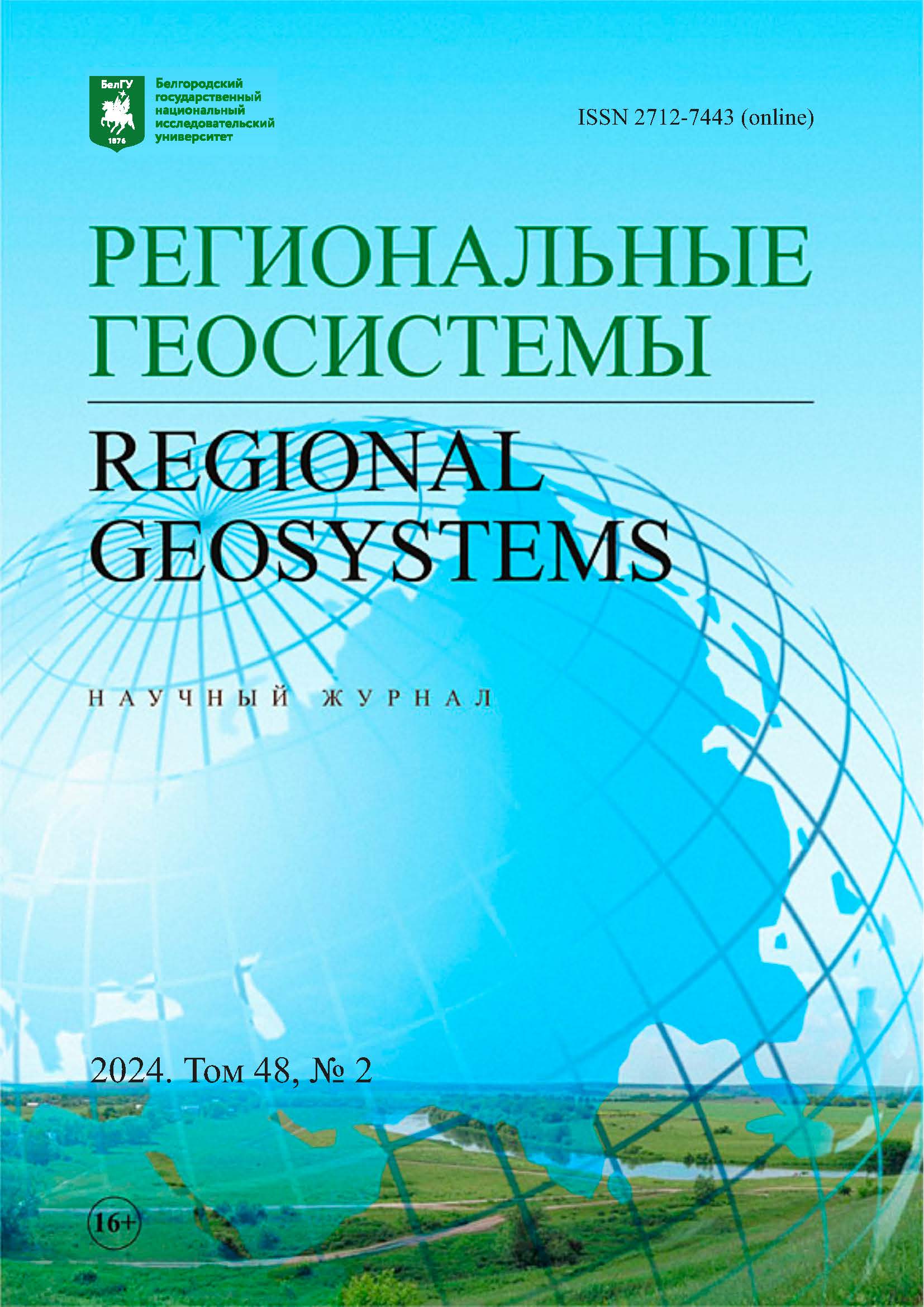Spatial and Seasonal Variability of NO2, SO2 and CO Contents over the Territory of Belarus
DOI:
https://doi.org/10.52575/2712-7443-2024-48-2-210-220Keywords:
air pollution, Sentinel-5P TROPOMI, sulfur dioxide, nitrogen dioxide, carbon monoxide, BelarusAbstract
The purpose of the research is to study changes in the tropospheric contents of NO2, SO2 and CO on the territory of Belarus, measured using satellite imagery. Based on the results of the Sentinel-5P TROPOMI satellite (winter and summer 2022), average concentrations were obtained over cities, specially protected natural areas and for Belarus as a whole. Significant seasonal fluctuations in the contents of NO2, SO2 and CO have been established. In winter, average and median SO2 concentrations are 23,77 and 17,9 times higher than summer ones, respectively; NO2 – by 3,35 and 2,69 times, CO – by 1,16 and 1,17 times. The NO2 content over cities is 1,2 times higher than over specially protected natural areas. In summer, the highest concentrations of NO2 were observed over Gomel, Grodno, Brest, Minsk, Rechitsa, Svetlogorsk; in winter – over Minsk, Gomel, Novopolotsk, Vitebsk. SO2 concentrations are characterized by strong spatiotemporal variability. The concentrations of SO2 and CO over cities and protected areas are close and do not differ statistically significantly from the background.
Acknowledgements: The research was carried out with the financial support of the Belarusian Republican Foundation for Fundamental Research (project No. X23KI-022).
Downloads
References
Битюкова В.Р., Шимунова А.А. 2020. Региональный анализ дифференциации промышленного загрязнения атмосферы на постсоветском пространстве. Региональные исследования, 4: 82–96. https://doi.org/10.5922/1994-5280-2020-4-7.
Бондур В.Г., Воронова О.С., Черепанова Е.В., Цидилина М.Н., Зима А.Л. 2020. Пространственно-временной анализ многолетних природных пожаров и эмиссий вредных газов и аэрозолей в России по космическим данным. Исследования Земли из космоса, 4: 3–17. https://doi.org/10.31857/S0205961420040028.
Гусев А.П. 2023. Оценка риска деградации лесных геосистем под воздействием загрязнения атмосферы на основе съемки сенсора TROPOMI спутника Sentinel-5P (на примере восточной части Белорусского Полесья). Российский журнал прикладной экологии, 1: 10–15. https://doi.org/10.24852/2411-7374.2023.1.10.15.
Ивлиева М.С. 2023. Исследование загрязнения приземной атмосферы в Тульской области с использованием сервисов Copernicus. Известия Тульского государственного университета. Технические науки, 3: 551–554.
Катковский Л.В. 2020. Определение загрязнения атмосферы мегаполисов по данным космической съемки. Журнал Белорусского государственного университета. Физика, 3: 4–16. https://doi.org/10.33581/2520-2243-2020-3-4-16.
Курсов С.В. 2015. Монооксид углерода: физиологическое значение и токсикология. Медицина неотложный состояний, 6(69): 9–16.
Морозова А.Э., Сизов О.С., Елагин П.О., Агзамов Н.А. 2022. Интегральная оценка качества атмосферного воздуха в крупнейших городах России на основе данных TROPOMI (Sentinel-5P) за 2019-2020 гг. Современные проблемы дистанционного зондирования Земли из космоса, 19(4): 23–39. https://doi.org/10.21046/2070-7401-2022-19-4-23-39.
Прогноз состояния природной среды Беларуси на период до 2035 года. 2022. Минск, Беларуская навука, 332 с.
Силаева П.Ю., Силаев А.В. 2018. Особенности рассеивания выбросов диоксида азота предприятиями энергокомплекса и их влияние на население мегаполисов. Вестник Российского университета дружбы народов. Серия: Экология и безопасность жизнедеятельности, 26(1): 63–72. https://doi.org/10.22363/2313-2310-2018-26-1-63-72.
Тронин А.А., Киселёв А.В., Васильев М.П., Седеева М.С., Неробелов Г.М. 2021. Мониторинг содержания диоксида азота в воздушном бассейне России по спутниковым данным в условиях пандемии COVID-19. Современные проблемы дистанционного зондирования Земли из космоса, 18(3): 309–313. https://doi.org/10.21046/2070-7401-2021-18-3-309-313.
Cersosimo A., Serio C., Masiello G. 2020. TROPOMI NO2 Tropospheric Column Data: Regridding to 1 km Grid-Resolution and Assessment of their Consistency with In Situ Surface Observation. Remote Sensing, 12(14): 2212–2235. https://doi.org/10.3390/rs12142212.
Filonchyk M., Hurynovich V., Yan H., Gusev A., Shpilevskaya N. 2020. Impact Assessment of COVID-19 on Variations of SO2, NO2, CO and AOD over East China. Aerosol and Air Quality Research, 20: 1530–1540. https://doi.org/10.4209/aaqr.2020.05.0226.
Filonchyk M., Peterson M.P., Gusev A., Fengning H., Haowen Ya., Liang Zh. 2022. Measuring Air Pollution from the 2021 Canary Islands Volcanic Eruption. Science of the Total Environment, 849: 1–12. https://doi.org/10.1016/j.scitotenv.2022.157827.
Ialongo I., Virta H., Eskes H., Hovila J., Douros J. 2019. Comparison of TROPOMI/Sentinel-5 Precursor NO2 Observation with Ground-Based Measurements in Helsinki. Atmospheric Measurement Techniques, 13: 205–218. https://doi.org/10.5194/amt-13-205-2020.
Ionov D.V. 2010. Tropospheric NO2 Trend Over St. Petersburg (Russia) as Measured from Space. Russian Journal of Earth Sciences, 11(4): ES4004. https://doi.org/10.2205/2010ES000437.
Khan R., Kumar K.R., Zhao T. 2021. Assessment of Variations of Air Pollutant Concentrations During the COVID-19 Lockdown and Impact on Urban Air Quality in South Asia. Urban Climate, 38: 100908. https://doi.org/j.uclim.2021.100908.
Makineci H.B., Arıkan D., Alkan D., Karasaka L. 2021. Spatio-temporal Analysis of Sentinel-5P Data of Konya City Between 2019–2021. Harita Dergisi, 170: 23–40.
Shen L., Gautam R., Omara M., Zavala-Araiza D., Maasakkers J.D., Scarpelli T.R., Lorente A., Lyon D., Sheng J., Varon D.J., Nesser H., Qu Zh., Lu X., Sulprizio M.P., Hamburg S.P., Jacob D.J. 2022. Satellite Quantification of Oil and Natural Gas Methane Emissions in the US and Canada Including Contributions from Individual Basins. Atmospheric Chemistry and Physics, 22: 11203–11215. https://doi.org/10.5194/acp-22-11203-2022.
Zhu Z., Chen B., Zhao Y., Ji Y. 2021. Multi-Sensing Paradigm Based Urban Air Quality Monitoring and Hazardous Gas Source Analyzing: a Review. Journal of Safety Science and Resilience, 2(3): 131–145. https://doi.org/10.1016/j.jnlssr.
Abstract views: 191
Share
Published
How to Cite
Issue
Section
Copyright (c) 2024 Regional Geosystems

This work is licensed under a Creative Commons Attribution 4.0 International License.


